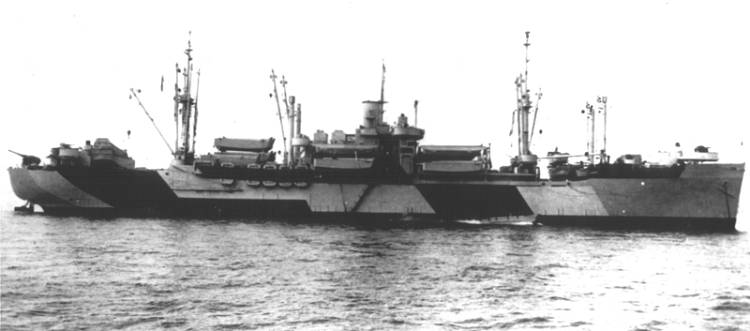|
U.S.S. Missoula WWII naval namesake serve with distinction Montana Missoulian Tuesday August 15, 1995 by Gary Glynn for the Missoulian |
||
|
|
||
|
Commissioned in the fall of 1944, the USS Missoula was retired on Sept. 13, 1946 after witnessing some of the war's bloodiest battles. |
||
|
"We are proud that our vessel bears the name of your fair city, and thank you for the interest you've extended in our ship." Navy Cmdr. Alex C. Kopper, Captain of the attack transport USS Missoula, wrote those words to Missoula Mayor Dwight Mason in 1945. During the last year of World War II, the ship named for Missoula County plied the Pacific Ocean, carrying combat troops into some of the bloodiest battlefields in American history. (During World War II, it was common for ships to be named after cities or counties as morale boosters.)
Built in four months at Kaiser Yard No. 2 in Richmond, Calif., the Missoula was commissioned during the fall of 1944. After a shakedown cruise on the West Coast, the transport sailed to Hawaii in December of that year. According to the letter from Kopper, the Missoula even had one Missoula man aboard, Yeoman 2nd Class Lawrence P. Smith.
By February 1945, the Missoula was part of the huge invasion fleet that assembled off the tiny island of Iwo Jima. Just before the men of the 28th Marines were landed on the hostile beach by the Missoula's boat crews, one of the Marine officers obtained a small American flag from the ship's store.
Thousands of scared Marines and sailors erupted into spontaneous applause when the men of Easy Company, 28th Marines scaled Mount Suribachi and raised the flag taken from the Missoula. A photograph of the raising of a second, larger flag on the same site became one of the best-known images of the war.
Shortly after the flag-raising, the Missoula left Iwo Jima with four surgical teams and some of the first casualties of the bloody fighting. The wounded men were dropped off at Saipan and the Missoula sailed south to the island of Espiritu Santo to pickup another load of soldiers. Starting on April 9, 1945, the Missoula spent five days landing part of the U.S. Army's 27th Division on Okinawa.
Harvey Rasmussen, a native of Sidney who now lives in Massachusetts, served as a coxswain aboard the Missoula.
"We did shoot down one kamikaze plane at Okinawa," t he said. "I vividly remember that. I was on the quad-40mmon the bow. All the guns were trained on it. It was spectacular. You could see all the tracers going into the plane but nothing happened. Just a short while before it got to the ship the whole thing exploded. Debris came down all over the ship."
After that close call, the Missoula left Okinawa with a load of wounded men bound for the hospital ships anchored at Saipan, then underwent a month of repair work at Ulithi Atoll. When repairs were completed, troops of the 1st Cavalry Division boarded the ship and began training exercises for the proposed invasion of Japan.
The training was abruptly canceled on Aug. 15, and the Missoula steamed for Tokyo Bay. As Japanese foreign minister-Mamoru Shigemitsu signed the surrender papers aboard the USS Missouri, the Missoula steamed past and disembarked some of the first occupation troops in Tokyo. The ship then sailed for the Philippines to pickup another load of occupation troops. These men, of the 41st Division, were landed at Hiro Bay, just a few miles from the epicenter of-the first atom bomb.
The ship then was detailed as part of the "Magic Carpet' fleet charged with bringing troops home from the war. During three Magic Carpet runs, the Missoula returned nearly 6,000 Pacific veterans to the United States. The ship was decommissioned on Sept. 13, 1946, in California and for a while was held as Part of the Pacific Reserve Fleet. It was eventually sold and converted into a merchant ship.
Rasmussen, who served aboard the ship during the Missoula's entire Navy career, remembers that "we were a fortunate ship. We went through two major invasions, and as far as I know, nobody aboard that ship was seriously wounded or killed." |
||
